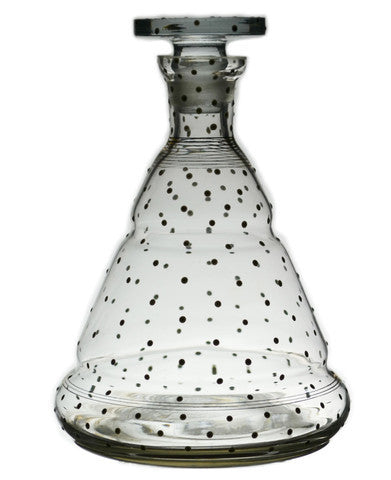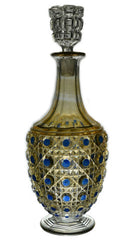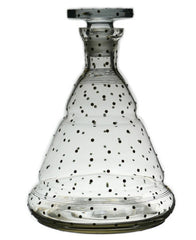Antique Glass Port and Sherry Decanters

Port has long been known as the Englishman’s wine. Since the early 18th century Englishmen have manufactured it in Portugal and shipped home, and probably more than any other nation, they have drunk it in great quantities. In its heyday, port was far more than a glass or two after dinner. It was not unknown to drink a few bottles of port at a party. It was primarily drunk by men at the after party, when ladies retired from the dinner table to drink tea. Considering that the price of port made it largely a wine for the wealthy, it can be assumed that for many an old-fashioned Victorian gentleman, port was the vine de table, as well as the preferred beverage in the smoking ad billiard rooms. When cigars were alight and the decanter was passed around the table, always from right to left, it was mainly port and no other drink.

The port decanter, which played such a central part in this clockwise after-dinner ritual, was essentially the same as that used for sherry, Madeira wine or other popular fortified wines. It has its origins in the bulbous, long necked decanter bottle used in the 17th century for serving wine from cask at the table. Since this method also ensured that bottled wine could be served free of sediment, the decanter, as it became to be known by the early 18th century, rapidly became a permanent piece of tableware.
Georgian designers were very quick to develop many of the basic decanter shapes that remained popular ever since. These included bottle-shaped and bell-shaped decanters, club-shaped decanters with straight, sloping sides and a shoulder, the wide-based ship decanter and the square-sectioned whiskey decanter. Standard sizes included the pint, the quart and the double quart or magnum. Decanters used for serving fortified wines or spirits were provided with tightly fitting ground glass stoppers to keep the contents sealed and air-tight. Towards the end of the 18th century most circular decanters were made with two or three raised rings around the neck, to ensure a good grip for a possibly unsteady hand.

Some decanters were engraved with descriptions of their contents – port, sherry and Madeira are three most common names. However, most decanters were unnamed. More often the contents were identified by silver labels with engraved names that hung on chains around the decanter neck.
Early Victorian designers and manufacturers approached the decanter with the same excessiveness that they brought to all useful or decorative objects. Their enthusiasm for glassware is partly explained by the removal of heavy glass taxation in the 1845, which was taxing glass objects according to their weight. Prior to this date glass makers thought twice before adding non-functional decoration to glass objects. But suddenly, all such restrictions were removed and the result was an explosion of heavy decoration.
To satisfy the love for novelty, Victorians borrowed nearly every decanter design of the previous Georgian century and added a few original shapes of their own. Although there was no one typical Victorian decanter shape, fashions gradually changed from the typical Georgian cylinder style to a bulbous bodied shape with a narrow neck. Later on this evolved into an extremely popular late Victorian shape, which was an imitation of ancient Greek pottery with a slender neck above an egg-shaped body resting on a base or foot. Stoppers were another important part of a decanter design – typical shapes included mushrooms, balls, pinnacles and cartwheels.
Regency decanters were usually ornately cut, and the early Victorian followed this fashion. Bu the popularity of the cut glass decoration declined somewhat with the introduction of press moulded glass in the 1830’s. This was brought from America and looked like cut glass and cost only a fraction of the latter. Additionally, John Ruskin, an eminent art critic of the Victorian period, described cut glass decoration as “barbarous” and preferred plain functional glass to be used.
Those who did not like plain glass, there were a variety of decorative techniques available. Overlay technique was also known as flashing – in which two or more colours of glass were superimposed and then decoratively cut. Decanters were also engraved with flowers, ferns, fruit, vines, sporting and classical scenes. Etching with acid was a cheaper technique, which gave the same effect as engraving, but with somewhat softer outlines.
Victorians loved coloured glass. The rich blues and greens of the Bristol factories were particularly popular, while pinkish-red cranberry glass was a passion for some collectors. On the whole, delicate tints such as apple green, amber, amethyst and straw opal were more popular than dark colours. Sometimes colours were simply painted in decorative strips over the surface of a plain glass decanter. However, because wine itself has a deep red attractive colour of its own, most decanters remained uncoloured.
Decanters frequently came in sets – a pint, a quart and a claret decanter comprising a typical combination. The young couple setting up on their own would usually buy a set with matching glasses. These could be bought from Harrods, for example, that used to sell such matching sets comprising of several dozens of items. The tantalus, a wooden and metal stand containing a set of cut-glass decanters was popular with Victorian households who wanted to make sure the servants did not drink the contents. It was named after Tantalus – the tortured Greek figure from the mythology, who stood in water but was unable to take a drink. The tantalus sets were locked with a key, thus not allowing taking a decanter out. A more generous device for holding decanter sets was the silver decanter trolley, a small four-wheeled platform that was pushed around the table top, from right to left. The baize-bottomed wine coaster or bottle slide was used for the same purpose.
By the end of the Victorian era the great age of port drinking was over. Whisky, gin and bitters and the French table wines replaced the fortified wine, bringing with them new glassware designs, which we will discuss further.






